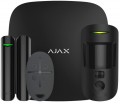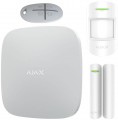Wireless zones
The number of security zones that can be covered by this kit when using wireless sensors.
In this case, a security zone means a separate protected area for which you can separately set the operating mode — for example, "Protection", "Protection disarmed" or a special tracking format. On many models, the number of zones corresponds to the maximum number of wireless sensors that can be connected to the device (see "Wireless Sensors"). However, there are exceptions: for example, a model for several dozen sensors can have 6-10 protection zones, in the expectation that one zone will be served simultaneously by several sensors.
Backup power
The time that the alarm is able to work on its own built-in power supply, in case of failure of an external power source.
Backup power allows the security system to remain operational during power outages (including during deliberate shutdown). The longer the time of operation on backup power, the more reliable the alarm, the lower the likelihood that due to power outages, the security will be completely disabled. At the same time, note that the specifications usually indicate an “perfect” battery life, with minimal power consumption; in fact, this period may be less — depending on the specific mode of operation, the frequency of operations and the quality of the batteries used (if replaceable batteries play the role of an autonomous source). So it is worth choosing according to this indicator with a certain margin — at least 15 – 20%.
Security functions
—
Partial security. Possibility of work of a set in the mode of partial protection. In this mode, the alarm does not arm the entire protected space, but only a part of it — for example, individual rooms, or only sensors of a certain type (opening, movement). Specific features of the partial protection format may be different, they should be specified separately in each model. However, anyway, this function expands the capabilities of the signaling and may be useful in some specific situations. For example, in a residential building at night, you can turn on the perimeter sensors without using motion sensors — in this way, the alarm will only turn on when you try to enter the house and will not respond to people inside.
—
Alarm on pressing the button. Possibility to turn on the alarm signal manually by pressing a special button. This function will be indispensable in extreme situations in which automatic sensors are useless — for example, during an open robbery or attack. Specific alarm functions, of course, may be different: some models include a siren, others are able to send a signal to the dispatcher's console, etc.; these details should be specified separately.
—
Auto arming. Possibility of automatic arming of the alarm system. Most often, in this case, the inclusion of protection is implied by the schedule of hours and days of the week specified b
...y the user; some models allow you to store several schedules in memory at once. This feature ensures that the protected zone "out of hours" will not be left without an alarm, even if the user forgets to turn it on manually. In addition, other methods of auto-arming may be provided — for example, when all key fobs are removed from the communication zone; the presence of such functions should be clarified separately.Max. wireless sensors
The number of wireless sensors that can be simultaneously connected to the central unit (if this connection format is supported — see "Connecting sensors"). This number, by definition, is not less than the number of wireless zones (see the relevant paragraph).
Note that even the most modest modern systems support 6 – 8 wireless sensors, in the most advanced models this number can exceed 100. So you have to pay attention to this parameter mainly in cases where you need to organize a very extensive alarm system.
Key fobs communication range
The distance at which the connection of the control key fobs with the central alarm unit is maintained. This is a rather approximate, moreover, a very conditional indicator: the characteristics usually indicate the distance in perfect conditions — with line of sight, without interference and obstacles between the key fob and the control panel. In fact, the communication range may be less than stated, especially if the key fob has to work through walls. So it is worth choosing according to this indicator with a certain margin.
Also note that this parameter is indicated in the specifications for regular key fobs — complete or recommended by the manufacturer; when using "non-native" accessories, the communication range may be reduced.
Users (numbers to call)
The number of users or voice call numbers that can be stored in the device's memory.
The very possibility of a call, of course, is found only in models with support for remote control — via GSM or Wi-Fi (see "Control"). Systems with this function, when triggered, send a voice call to specified users via the mobile network to a phone or via the Internet to an application on a smartphone / tablet. Having accepted the call, the user receives voice information about the details of the alarm, and also, in most cases, gets access to additional functions: control via the voice menu, intercom, listening (see "Control panel capabilities"), etc. Many modern alarm systems allow set not one recipient of such calls, but a whole list: if there is no connection with one user, the system will try to call the second, if he does not answer, the third, etc. This will be useful in cases where several people are responsible for signaling.
Motion sensor
Model of the motion sensor(s) supplied with the alarm.
The main data on the motion sensor — coverage angles, range — are usually given in the characteristics of the kit (for more details about this data, see below). However, knowing the name of the model, you can find more detailed information about it — up to practical reviews. In addition, the model name will be useful when looking for spare or additional sensors, in addition to the complete ones.
Tamper
The presence of a tamper in the devices included in the set.
A tamper is a device that protects the body of the device from unauthorized opening and interference with work. The simplest tamper is a microswitch that is triggered when the case is opened and sends an alarm signal to the alarm. In addition to this, advanced equipment can be provided — for example, a switch that reacts to an attempt to tear the sensor away from the wall. The tamper is usually equipped with at least complete sensors, and in some cases — the control panel; these points should be clarified separately. Of course, such equipment does not provide absolute protection against interference, but it noticeably “makes life difficult” for an attacker who decides to spoil the alarm.
Operating temperature
The air temperature range in which the alarm components maintain normal operation.
This parameter is important first of all in cases where the alarm is planned to be used outdoors or in unheated rooms. Particular attention in such cases should be paid to whether the system can work
at sub-zero temperatures. If we are talking about room temperatures (plus or minus), then you can’t really look at the claimed temperature range — almost any alarm is suitable for such conditions.

